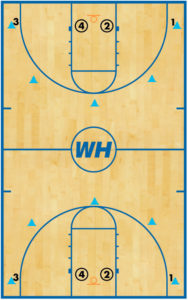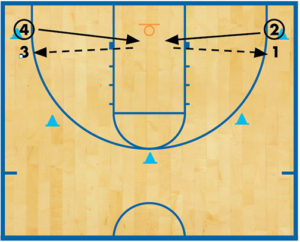Competitive shooting drills to challenge players
Pushing the pace of your players during practice, or forcing them to compete against one another, properly prepares them for game-time situations. Here are two drills you can implement into your system, helping them improve shooting, rebounding, passing and conditioning.
Eagle shooting
There are five spots to shoot from in this drill, which can be done at both ends of the court. Mark off shooting spots in the corners, wings and at the top of the key.
 DIAGRAM 1: Eagle shooting. Players start in pairs, usually with two paired groups to one basket. If you have enough baskets and court space, you can go with one paired group per basket.
DIAGRAM 1: Eagle shooting. Players start in pairs, usually with two paired groups to one basket. If you have enough baskets and court space, you can go with one paired group per basket.
In this example, the teams are 1/2 and 3/4. One teammate starts with the ball under the basket and the other person is the shooter.
First round: This round of competition lasts three minutes and shooters are required to make five baskets from each spot along the perimeter. All groups compete against one another to get the highest score. Shooters take shots for the entire three minutes while their teammates rebound.
A shooter cannot move on to the next spot until five shots are made from the current location. For every shot made, teams receive one point. The players report their total points to the coach and switch roles with their partners, again performing the tasks in round one (shooters become rebounders and rebounders become shooters).
Second round: Shooting intervals are cut from three to two minutes. Another change in this round is that shooters are required to make two consecutive shots from one spot before they move on to the next location.
Each successful completion of one spot is counted as two points. If a player fails to complete a spot, they are not awarded partial points. For example, if a shooter completed four locations and made one basket on the fifth location as time expired, they are awarded eight points total. Not nine.
Once time has expired, the scores are reported to the coach and players reverse roles, running through round two a second time.
 DIAGRAM 2: Third round. In round three, time is increased to five minutes. Shooters now must take a shot, chase down the rebound and pass it to their partners. Teammates exchange every shot and teams are required to make five shots as a pair before moving on to the next location. Scores are reported to the coach, but this round is not repeated.
DIAGRAM 2: Third round. In round three, time is increased to five minutes. Shooters now must take a shot, chase down the rebound and pass it to their partners. Teammates exchange every shot and teams are required to make five shots as a pair before moving on to the next location. Scores are reported to the coach, but this round is not repeated.
 DIAGRAM 3: Fourth round. In the fourth and final round, players shoot 10 free throws each. There is no time limit during this round. Teams combine the scores of both shooters (one point for each successful shot) and report it to the coach.
DIAGRAM 3: Fourth round. In the fourth and final round, players shoot 10 free throws each. There is no time limit during this round. Teams combine the scores of both shooters (one point for each successful shot) and report it to the coach.
The coach then combines the scores for each team from every round determining the winner. Winning teams are not punished, but coaches can determine consequences for other teams.
Marquette shooting
 DIAGRAM 4: Marquette shooting (A). Players line up at the top of the key and the first three players in line have basketballs. 1 dribbles to the right elbow and shoots while 2 dribbles to the left elbow and shoots. Both players get their own rebounds. As they are doing so, 3 dribbles at the right elbow and shoots (players always go to the opposite elbow as the player in front of them).
DIAGRAM 4: Marquette shooting (A). Players line up at the top of the key and the first three players in line have basketballs. 1 dribbles to the right elbow and shoots while 2 dribbles to the left elbow and shoots. Both players get their own rebounds. As they are doing so, 3 dribbles at the right elbow and shoots (players always go to the opposite elbow as the player in front of them).
 DIAGRAM 5: Marquette shooting (B). As the players rebound their own shots, they form an outlet line in the corner. A rebounder passes to the outlet person, who then passes to the coach and hustles back in line.
DIAGRAM 5: Marquette shooting (B). As the players rebound their own shots, they form an outlet line in the corner. A rebounder passes to the outlet person, who then passes to the coach and hustles back in line.
Once the ball gets to the coach, the next person in line runs full speed toward an elbow, receives the pass from the coach and shoots. They then get their own rebound and pass to the outlet line. The pattern continues for the duration of the drill, which lasts three minutes.
This drill is done with three basketballs, so communication is important. Hustling also is important in order to get as many shot attempts as possible. For my team, the players have three minutes to make 30 shots. You can adjust accordingly depending on your team’s abilities.









